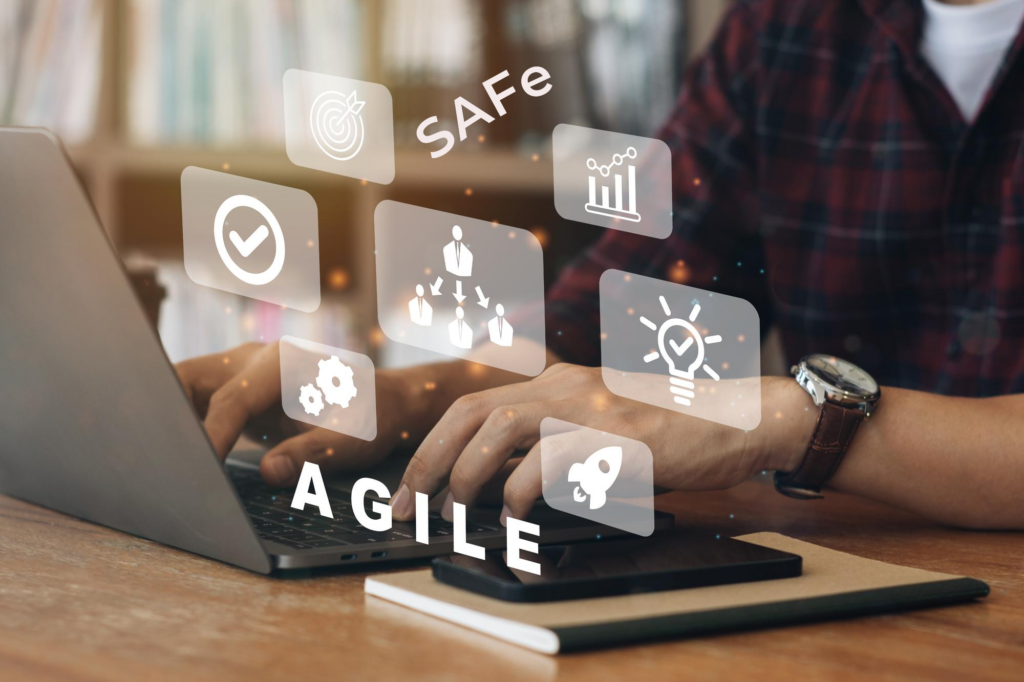Table of Contents
ToggleBefore we delve deep into the differences between SAFe and Agile, we have to understand that both are software development methodologies, and SAFe is a “customized version” of Agile, in the sense that SAFe does the same things but in a scaled environment. It is of paramount importance that we know the basics of both to understand the differences between them.
What is SAFe (Scaled Agile Framework)?
Scaled Agile Framework (SAFe) is a set of organizational and workflow patterns used for the application of Agile practices across an enterprise. The framework is a body of knowledge that includes structured guidance on roles and responsibilities, planning and managing work, and the values to adhere to.
SAFe promotes the consistency, collaboration, and delivery of a large number of Agile teams. It is built around three main knowledge systems:
- Agile software development
- Lean product development
- System thinking.

The Scaled Agile Framework aims to improve the entire business by inspiring simplified decision-making across functional and organizational boundaries. These principles are intended to influence the decisions of the leaders managers and all members of the organization. It is the prime motive of SAFe to condition the traditional hierarchical thinking of the members of an organization to Agile thinking so that practices such as Lean portfolio management may be applied.
What is Agile?
Agile is one of the software development methodologies. The importance of Agile is to enhance the teams to deliver the product faster and in less pain, with a greater likelihood of success. But today, Agile is no longer restricted only to the Software industry. It is finding widespread application in varied businesses, which have found the Agile way of working highly efficient and profitable by responding to customers’ needs better and thereby improving the business value of their respective organizations.

Difference Between SAFe and Agile
Principles and Modus operandi– Agile teams are small units of people, usually 10 or fewer, which utilize the Agile methodology of software development to enable faster delivery of products to the stakeholders. The idea is to do this with greater efficiency and with lesser difficulty.
On the other hand, SAFe ensures product delivery by coordinating for smooth collaboration between a large number of Agile teams across a large organization.
Advantages of Agile and SAFe
SAFe Advantages
SAFe is scaled Agile; hence whenever there are a large number of multi-functional teams working on a common goal, SAFe is the go-to resource. Some unique advantages that SAFe provides are:
- SAFe helps cross-functional teams to collaborate, cutting down interdependence efficiently.
- SAFe ensures greater transparency by helping stakeholders in different groups receive faster feedback.
- SAFe helps in aligning the ongoing project with the broader aspirations and vision of the organization.
- SAFe helps make it possible to use applications like Scrum and Kanban in large organizations by scaling them to be of use in these larger businesses.
- SAFe helps in the quick delivery of the project, from planning to market.
Agile Advantages
- Agile ensures the delivery of a superior-quality of product.
- It ensures total customer satisfaction.
- Agile helps the team have better control over the ongoing project and the outcome because of the flexibility Agile provides at each step.
- Due to the constant review and communication within the team, Agile teams have vastly improved the predictability of their product.
- In continuation of the point above, due to regular communication and review, risks are averted, as they are understood way ahead of product delivery.
- The Agile teams enjoy great flexibility concerning their work environment and hence make happy teams.
- Agile strives for continuous improvement.
- Agile ensures that the morale of its team members is always high.
Core Values of Agile and SAFe
SAFe Core Value
The SAFe core values delineate the culture leaders should inculcate and team members should follow to use the framework more efficiently. SAFe works on four core values:
- Alignment
- Integrated quality
- Transparency
- Program Execution
Agile Core Values
- Individuals and interactions over processes and tools.
- Working software over comprehensive documentation.
- Customer collaboration over contract negotiation.
- Responding to change over following a plan.
Conclusion
Thus we see that SAFe is a methodology that is dependent on the Agile framework and is a scaled version of the latter, to ensure the successful completion of projects using the Agile framework in larger businesses and organizations. Large-scale projects will need SAFe, whereas small projects can be dealt with Agile. Depending on its structure, number of employees at its disposal, stakeholder requirements, and involvement of management in the project, companies choose which framework, Agile or SAFe, will be more suited to their purpose. At Spoclearn we provide Agile certification programs in Agile Scrum Foundation Training, Agile Scrum Master Training, ASPO Training, and CSM Training for both individuals and enterprise teams.
